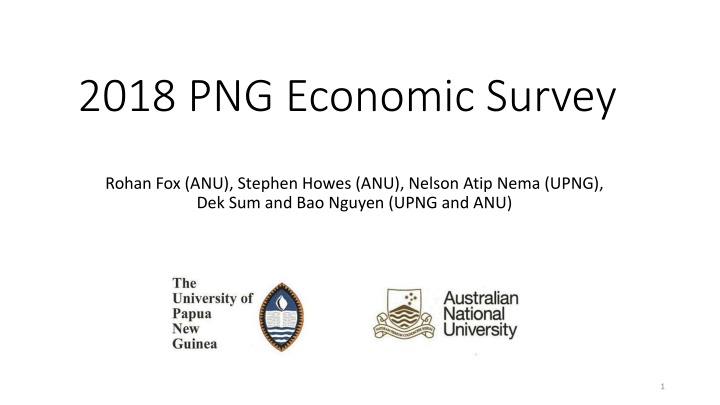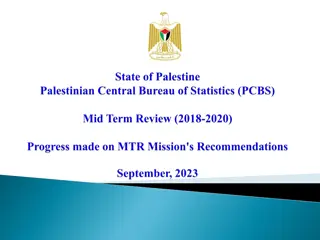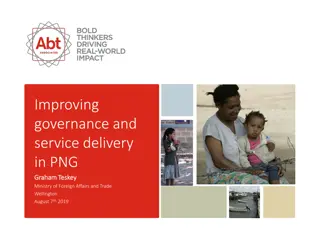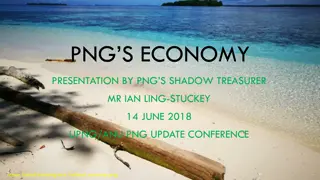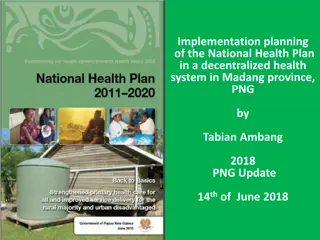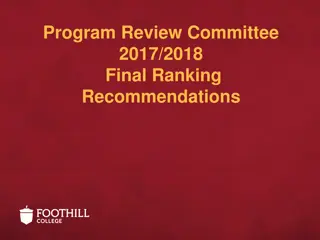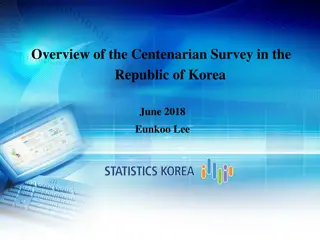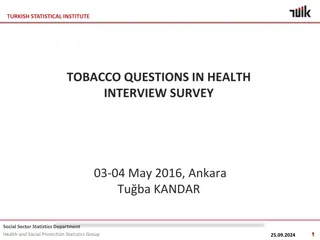2018 PNG Economic Survey: Analysis and Recommendations
The 2018 PNG Economic Survey conducted by a team of experts highlights the challenges faced by the non-resource economy in Papua New Guinea. The report emphasizes the need for policy actions to stimulate growth, address foreign exchange shortages, and boost employment. Data indicates a recession in the non-resource sector in 2015, with declining formal sector employment since 2013. The survey suggests a focus on fiscal and macroeconomic policies to stabilize the economy.
Download Presentation

Please find below an Image/Link to download the presentation.
The content on the website is provided AS IS for your information and personal use only. It may not be sold, licensed, or shared on other websites without obtaining consent from the author.If you encounter any issues during the download, it is possible that the publisher has removed the file from their server.
You are allowed to download the files provided on this website for personal or commercial use, subject to the condition that they are used lawfully. All files are the property of their respective owners.
The content on the website is provided AS IS for your information and personal use only. It may not be sold, licensed, or shared on other websites without obtaining consent from the author.
E N D
Presentation Transcript
2018 PNG Economic Survey Rohan Fox (ANU), Stephen Howes (ANU), Nelson Atip Nema (UPNG), Dek Sum and Bao Nguyen (UPNG and ANU) 1
Introduction The fifth in our series of annual economic surveys. A joint ANU-UPNG project providing independent, expert economic analysis. Based on interviews as well as our own research. 2
Introduction Growth Fiscal/macro Private sector Conclusion Key messages Focus on the non-resource economy: where nearly all PNGians work. The non-resource economy has not been doing well, with sluggish and even negative growth. This is resulting in a loss of jobs and poor service delivery. The main drag on growth is the shortage of foreign exchange. To stimulate growth, which needs to be the government s top priority, it needs to depreciate the exchange rate, which is the only way to address foreign exchange shortages. 3
Introduction Growth Fiscal/macro Private sector Conclusion Structure Introduction Section 2 Economic growth Section 3 Fiscal trends and macro policy Section 4 Private sector policies and perspectives Conclusion 4
Economic growth Economic growth 5
Introduction Growth Fiscal/macro Private sector Conclusion New NSO data suggests non-resource recession in 2015 Table 1 Estimates of GDP, resource GDP and non-resource GDP real growth for 2015 GDP growth Resource GDP growth Non-resource GDP growth Value Source Value Source Value Source 2017 estimate 10.5% Treasury 48.3% Treasury 0.7% Treasury 2018 estimate 5.3% NSO 48.3% Treasury -5.9% NSO & Treasury combined Source: NSO (2018) and Treasury (2017) 6
Introduction Growth Fiscal/macro Private sector Conclusion Formal sector employment has fallen every year since 2013 Formal sector employment (March 2002=1) 7
Introduction Growth Fiscal/macro Private sector Conclusion Economy-wide taxes stabilized in 2017 Economy-wide taxes, 2014-2017 (adjusted for inflation) 8
Introduction Growth Fiscal/macro Private sector Conclusion There was some growth in imports in 2017 after a massive contraction Exports and imports of goods and services 9
Introduction Growth Fiscal/macro Private sector Conclusion But private sector credit growth was negative in 2017 10
Introduction Growth Fiscal/macro Private sector Conclusion Growth summary and outlook In 2015, the non-resource economy contracted by 5.9%. Likely that 2016 another year of negative non-resource growth. Non-resource growth performance in 2017 and this year still unclear. Mild boost this year from APEC, but businesses are not very positive short-term. Government itself is projecting growth only at 2.5-3.5% in the next few years, barely above population growth. Longer-term, business confidence rests on new resource projects, but there is considerable uncertainty as to timing. 11
Fiscal & macro Fiscal & macro 12
Introduction Growth Fiscal/macro Private sector Conclusion Credit downgrades Credit agencies rate the sovereign credit of countries based on their risk perception S&P downgraded PNG in April from B+ to B Moody s did the same downgrade to PNG (B1 to B2) two years earlier, and this year downgraded its outlook from stable to negative. These downgrades reflect PNG s ongoing fiscal and macro difficulties. 13
Introduction Growth Fiscal/macro Private sector Conclusion Government revenue Government revenue, adjusted for inflation 14
Introduction Growth Fiscal/macro Private sector Conclusion Resource revenue is very low Resource revenue is very low At lowest level since 1992. New projects are not paying taxes due to accelerated depreciation and/or tax holidays (PNG LNG, Ramu Nico) Old projects not paying much tax either. Why? Lower profitability in the case of Ok Tedi. Unclear in the case of Lihir There is a case for re-examining the resource revenue regime prior to the approval of new projects. 15
Introduction Growth Fiscal/macro Private sector Conclusion In addition to low revenue, need to reduce large deficits also constraining expenditure Government revenue minus expenditure 16
Introduction Growth Fiscal/macro Private sector Conclusion Debt is at record levels 17
Introduction Growth Fiscal/macro Private sector Conclusion Increasing debt is driving up interest payments 18
Introduction Growth Fiscal/macro Private sector Conclusion All of these factors make for a bleak expenditure outlook. 19
Introduction Growth Fiscal/macro Private sector Conclusion Inflation is heading down. Inflation in selected Pacific Island countries (%) 20
Introduction Growth Fiscal/macro Private sector Conclusion The exchange rate has been stable for the last two years. 21
Introduction Growth Fiscal/macro Private sector Conclusion But the real real exchange rate is at a record high. real exchange rate index and terms of trade 22
Introduction Growth Fiscal/macro Private sector Conclusion Foreign exchange reserves are depleted, but now stable due to foreign exchange rationing. 23
Introduction Growth Fiscal/macro Private sector Conclusion The large current account surplus is matched by a large capital account deficit. 24
Introduction Growth Fiscal/macro Private sector Conclusion The capital account deficit reflects profit repatriation. 25
Introduction Growth Fiscal/macro Private sector Conclusion Fiscal/macro summary The fixed nominal exchange rate is preventing the adjustment of the economy to the end of the boom, and forcing reliance on foreign exchange rationing. Weak revenue. smaller deficits, and higher interest means declining funds for service delivery. Progress on deficit reduction, but mounting arrears. Credit downgrades reflect perception of increased risk. All of these problems require faster economic growth, which only the private sector can provide the next section. 26
Private sector policies and Private sector policies and perspectives perspectives 27
Introduction Growth Fiscal/macro Private sector Conclusion The two-decade-long Tariff Reduction Program has been abandoned. pre- 1999 1999- 00 2001- 2 2003- 5 2006 2011 2012 12.5 20 35 2015 2018 Intermediate Protective Prohibitive 30 49 30 40 55 25 35 50 20 30 45 15 25 40 15 25 40 10 15 30 10 10 25 55-100 28
Introduction Growth Fiscal/macro Private sector Conclusion 2018 tariff developments Some 600 pre-legislated tariff reductions were abandoned. In addition, another 250 tariff lines increased. On average, tariff increases moderate (about 7% on average), but some exceptions: From 0% to 25% for milk 29
Introduction Growth Fiscal/macro Private sector Conclusion Selective tariff increases Old New Stockings, socks 15% 20% Clothes Cotton or woollen clothes 15% 20% Toilet paper 15% 20% Tablecloths 10% 20% Baths, sinks, washbasins 10% 25% Detergents 10%-15% 20%-25% Household and consumer items Glue 10% 20% Soap 15% 20% Shampoo 10% 20% Nail polish 10% 20% Ice cream 15% 20% Milk 0% 25% Food Cocoa products 10% 15% Meat 10%-15% 12.5%-20% 30
Introduction Growth Fiscal/macro Private sector Conclusion Commentary on 2018 tariff increases Past protectionist efforts have not succeded (Ramu Sugar; Halla Cement). Inconsistent with APEC. New system more complex (6 rates rather than 3). Result may be more lobbying. Import-competing industries do need assistance, but they would equally benefit from an exchange rate depreciation. Tariff increases do not help exporters 31
Introduction Growth Fiscal/macro Private sector Conclusion Tuna canning Last year, PNG announced that all tuna caught in PNG waters would need to be processed in PNG. Processors don t want to do this, despite offer of rebate, because PNG much more expensive (e.g. minimum wage 50% higher than in Philippines.) Recently, one of the six tuna processors closed down resulting in the loss of 800 jobs. Tariff increases will not help tuna processing, but exchange rate depreciation will. 32
Introduction Growth Fiscal/macro Private sector Conclusion Private sector surveys in PNG INA has undertaken four five-yearly surveys of PNG businesses since 2002 Since 2012, Business Advantage has undertaken 7 annual surveys of PNG businesses. What does business think? 33
Introduction Growth Fiscal/macro Private sector Conclusion PNG business surprised by recent economic performance Index of business performance against expectations (calculated from BA surveys) 34
Introduction Growth Fiscal/macro Private sector Conclusion Foreign exchange has been business s top worry for the last three years Top four impediments facing business according to the BA surveys 35
Introduction Growth Fiscal/macro Private sector Conclusion The INA survey gives the same message over a longer period Top three constraints 2007 6 5 4 3 2 1 0 Law and order Corruption Telecoms 2017 2012 6 6 5 5 4 4 3 3 2 2 1 1 0 36 0 Foreign exchange access Corruption Exchange rates Law and order Corruption Transport
Conclusion Conclusion 37
Introduction Growth Fiscal/macro Private sector Conclusion Top priority has to be a boost to non-resource GDP per capita 8000 7000 Kina (2013 prices) 6000 5000 4000 3000 2000 1000 0 2002 2003 2004 2005 2006 2007 2008 2009 2010 2011 2012 2013 2014 2015 2016 2017 non-resource GDP per capita resource GDP per capita 38
Introduction Growth Fiscal/macro Private sector Conclusion Top priority has to be a boost to non-resource GDP per capita 8000 7000 Kina (2013 prices) 6000 5000 4000 3000 2000 1000 0 2002 2003 2004 2005 2006 2007 2008 2009 2010 2011 2012 2013 2014 2015 2016 2017 non-resource GDP per capita 39
Introduction Growth Fiscal/macro Private sector Conclusion Need to get employment growth happening again. 40
Introduction Growth Fiscal/macro Private sector Conclusion Conclusion: diagnosis Focus on the non-resource economy: where nearly all PNGians work. The non-resource economy has not been doing well, with negative growth in 2015 and probably 2016 and at best sluggish growth since. This is resulting in a loss of jobs (negative job growth every year since 2013) and poor service delivery. The main drag on growth is the shortage of foreign exchange: that s what our analysis says and what business says. 41
Introduction Growth Fiscal/macro Private sector Conclusion Conclusion: remedy To stimulate growth, the government needs to depreciate the exchange rate, since this is the only way to address foreign exchange shortages. Not a new or popular idea, but if there was an alternative, it would have worked by now. Not a panacea and will have costs, but at this stage there is no alternative, and it will bring many benefits, especially to rural areas, where most PNGians live. 42
Postscript The main impediment to private sector development is macroeconomic policies. The main obstacle to business activity and investment are difficulties in obtaining foreign exchange. [We] recommend that the Kina be allowed to depreciate to eliminate the current over-valuation of the currency, end the FX shortage, and promote external competitiveness. IMF 2017, PNG Article IV 43
Tenkyu tru! Paper available soon from devpolicy.anu.edu.au or devpolicy.org Email: rohan.fox@anu.edu.au 44
